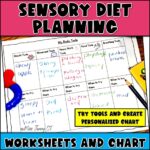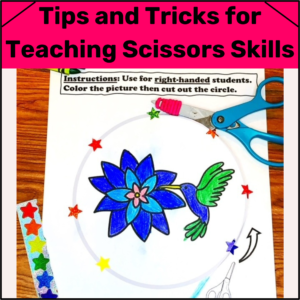“Sensory Diet” is a term that is sometimes thrown around but not always understood. A person who is not familiar with the term may think it involves food. A sensory diet involves a person having optimal sensory input during their day to assist with maintaining self-regulation. Food may be a small part of the sensory input needed.
Sensory Diet: Yay or Nay?
There are two main schools of thought on how to implement a sensory diet. (Note: “Yay” and “Nay” are terms that I made up for this post)
- Yay
- A strict schedule is set up when sensory input is provided to the child
- The sensory input may be passive (done to the child), or active (the child actively engages in an activity)
- The schedule is followed regardless of whether the child needs that type of input at that time
- Nay
- The sensory diet does not follow a set schedule
- The sensory input is given when the child demonstrates the need
- It is also given proactively in situations when the child has previously shown a need
- Caregivers read the child’s cues and provide the needed input (passive or active)
Example of Scheduled Sensory Diet
Let’s imagine Seth. Seth is an autistic child in 2nd grade. He is in general education for most of the day, but spends time in a smaller group for language arts and math. Seth has difficulty sitting in his chair for more than 5 minutes. He often roams around the classroom when the teacher is teaching. He may throw his paper or book when frustrated. Seth has a visual schedule with his sensory diet activities on it.
A structured sensory diet for Seth may look like this (very small sample of the day):
- School begins at 8:00 AM. Seth enters the classroom and his teacher puts a pressure vest on him
- At 8:30, Seth is guided to do wall push-ups in the back of the class
- At 9:00, Seth is given water to drink
- During recess, Seth is shown a visual schedule of the activities he must complete in order
- After recess, the pressure vest is removed
- During math, Seth goes to his small group. While there, the teacher does therapeutic brushing
- On the way back to his gen ed class, Seth follows a sensory path and does jumping, hopping, and skipping
- Seth is instructed to do chair push-ups at 1:00 PM
- Seth leaves at 2:00
During the day, Seth continued to have difficulty sitting in his chair and threw his book twice. His needs for that day were not met by his scheduled sensory diet. Having set activities to do at the same time, and in the same order did not meet his nervous system’s dynamic needs. Note that the pressure vest was put on and removed at set times without regard to whether it was needed. He did chair push-ups at a set time, which did not take into account how his nervous system was at that time.
Example of Dynamic Sensory Diet
Let’s consider Seth again, but from a dynamic point of view. With this type of “sensory diet”, his teachers have been trained to recognize his varied needs and the activities that help him regulate. Seth has a visual schedule that includes a section for activities to try based on his sensory needs. His teachers have determined which activities help him based on his cues.
- Seth arrives at school and is calm and happy. His teacher greets him and does not intervene
- Seth starts getting fidgety at his desk. His teacher asks him to come to her desk (movement break), and offers him a wiggle cushion (he accepts) and water (he declines)
- Seth is able to sit for 20 minutes using the wiggle cushion. Then, his teacher noticed that he is chewing on his shirt. She offers a water break (also provides movement), which he accepts, and a piece of gum.
- Seth enjoys carrying a box of balls out to recess (heavy work) and is calm when recess begins
- He chooses which activities to do on the playground and gravitates towards those that his nervous system needs that day (running and going down the slide)
- He has a lot of energy from recess, but carrying the box of balls helps him settle down
- His teacher noted that he seems to be getting frustrated during math. His breathing has gotten faster, and his face is turning red. She asks if he needs help and re-teaches the concept. She also models taking deep breaths, which he does. She co-regulates by staying calm, although she knows that he has thrown his book in the past.
- Seth chooses which parts of the sensory path he wants to do that day.
- At lunchtime, Seth eats carrots and beef jerky that his mom sent to give his mouth some heavy work.
- At 1:00, the entire class takes a movement break
- Seth leaves at 2:00 having had his needs met during the day. He did not throw anything and was able to stay seated and engaged when needed.
Following Seth’s needs and watching his cues enabled him to have a good day.
How to Determine What to Include
A team approach is best for creating a sensory diet. The team may include: gen ed teacher, special ed teacher, speech and language pathologist, behavior specialist, school psychologist, occupational therapist, and parent. The OT is an important member of the team due to the training they have in the nervous system and in creating sensory diets. The rest of the team is important for reporting results of trials, and how child responds in different settings.
The OT should do a sensory assessment (formal or informal) prior to recommending any sensory intervention. There are a variety of formal assessments that typically involve checklists based on caregiver/teacher observation. Informal assessments can be equally powerful. You can read about formal and informal sensory assessment in this blog post.
If possible, I like to involve the child in determining what supports will best help them. I created a resource for teens that teaches them about their sensory systems, and helps them create their own sensory strategies chart. You can find the resource by clicking the image.
The resource below is designed to help young kids create their own strategies chart. It consists of guided activities for the child to try then record how it made them feel. At the end, the child creates their own strategies chart using included images.
Finally, I also use a sensory diet template resource for all ages that helps determine tools in categories. The categories include: “Mouth Tools”, “Movement Tools”, “Heavy Work Tools”, “Hand Tools”, and “Breathing Tools”.
Any of these resources can be helpful in creating a structured or dynamic sensory diet. The resources help the child/teen learn how to know when their bodies need strategies and which ones are helpful for their nervous system.
Sensory Diet: Yay or Nay?
As an OT having worked with kids over 15 years, I say nay. I prefer to create a dynamic “sensory diet” for kids. If you look at the resources above, you will see that all of them are based on personal preference/response to sensory input. Teaching caregivers to assist students to access their personalized tools is more beneficial in the long run versus a structured schedule. Most students can have an active role in creating their personalized diet. Caregivers can observe the student’s reaction to sensory input when the student cannot express their preference. The blog post linked above reviews how to use observation to determine sensory needs.
Using a sensory diet that follows a dynamic approach still allows for some set strategies, which may include:
- Incorporating/embedding strategies into the student’s day, such as carrying a box of balls out to recess
- Utilizing strategies such as preferred seating, study corrals, and easy access to headphones
- Recommending certain types of food for snacks/lunch (generally chewy and/or crunchy)
Proactively providing strategies/embedding into the day is optimal no matter which type of sensory diet you choose to create. It is when the child has difficulties with regulation despite the embedded strategies that we look to their personalized “sensory diet” for additional in the moment strategies.
Comment below with how you use sensory diets!











